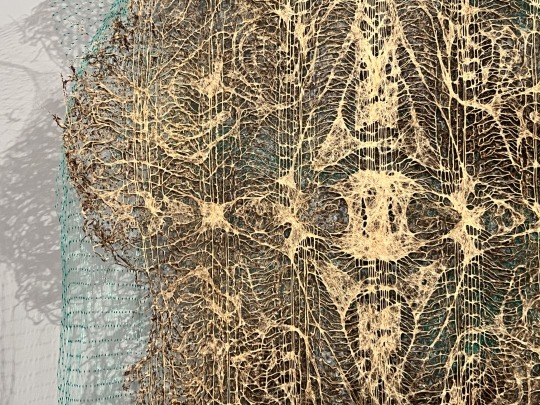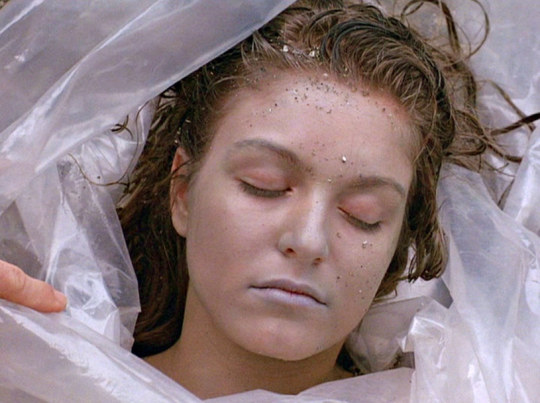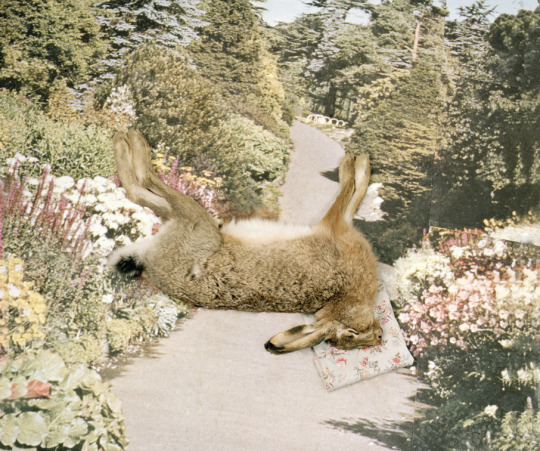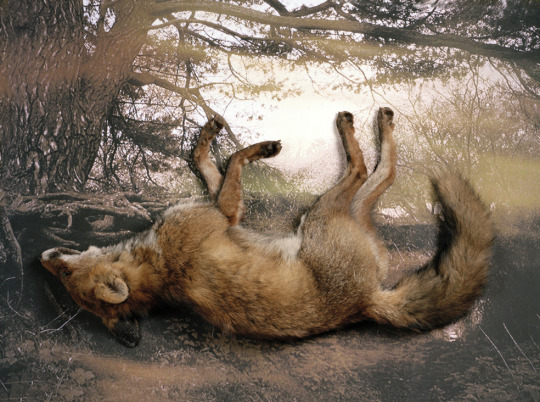#Diana Scherer
Text

Diana Scherer growing dress for Arcadia Triennale Oranjewoud Paradys 2022
27 notes
·
View notes
Text










Inter Woven
Exercises in Root System Domestication
Diana Scherer
Editing, compilation & concept Eleonoor Jap Sam, Mainstudio (Edwin van Gelder), Diana Scherer
Texts Giovanni Aloi, Phillip Fimmano, Colin Huizing, Herbert Kopp-Oberstebrink, Norbert Peeters, Judith Elisabeth Weiss, Jiwei Zhou
Design��Mainstudio (Edwin van Gelder)
Jap Sam Books, Prinsenbeek 2023, 204 pages, 23x31cm, ISBN 878943329034
euro 50,00
With a beautiful design by Mainstudio with a dust jacket and a range of beautiful paper types
An innovative research in grown plant root textiles and material by artist Diana Scherer
Visual artist Diana Scherer (1971, DE) is one of the pioneers in bio tech art. Scherer lives and works in Amsterdam, the Netherlands, where she studied fine art at the Rietveld Academy in Amsterdam. Her work comprises botany, installations, textile and biotechnology. Scherer explores the relationship of people versus their natural environment. Through her installations she examines the boundaries between plant culture and nature. At the core of her botanical installations and textiles lies a great curiosity about what neurobiologists call ‘the brain of plants’. Scherer studies plants and root systems and applies the intelligence of plants in her work.
This book summarized the project Interwoven and its results over the past eight years. The book with a conceptual design addresses biotechnology and research, in addition to the final results and artworks.
The invited authors highlight the various sides of the project from their fields of expertise. The design of the publication is made by Mainstudio (Edwin van Gelder, Moritz Eggmann), with texts by Giovanni Aloi, Colin Huizing, Judith Elisabeth Weiss & Hertbert Kopp-Oberstebrink, Philip Fimmano, Jiwei Zhou, and Norbert Peeters.
05/02/24
9 notes
·
View notes
Photo



DIANA SCHERER channels guts with elastics and cabbage. FEELING THIS.
9 notes
·
View notes
Text

December 07, 2023
#bergen#museum kranenburgh#farming textiles#tentoonstelling#diana scherer#wortels#planten#onbegrijpelijk#manipulatie
0 notes
Text

cr. diana scherer
#oddcore#midwest gothic#female photographers#rural gothic#deer#lost places#midwest aesthetic#small town#small town america#americana#photography#autumn#original photographers#credits#new england gothic#american gothic#weirdcore#art#midwest america#winter#strangecore#backwoods#alternative#dark#regional gothic
2K notes
·
View notes
Text








Diana Scherer was born in Germany and now lives and works in Amsterdam. She studied fine art at the Rietveld Academy in Amsterdam. Diana's art brings together botany, fibre art and sculpture.
Diana Scherer employs a unique technique that uses the natural growth process to create structures out of root tissues. She derives her patterns from shapes found in the botanical world, as well as from man-made structures. The results are unusual and poetic, invoking ecological balance between humans and nature.
26 notes
·
View notes
Photo







twin peaks 1x1 / jenna ortega in X / 3. ethel cain - sun bleached flies / diana scherer “collected” / joyce carol oates - where are you going where have you been / pretty girls by karin slaughter / house of wax “see paris die” ad campaign /
89 notes
·
View notes
Text
mingi avatars’s masterlist
clicando aqui você vai ser redirecionado para a minha lista completa de todos os avatares desse blog ♥ recomendo dar um ctrl+f pra achar o nome da pessoa rs
click here to be redirected to the masterlist of every avatar i made ♥ feel free to use ctrl+f to find their name lol
@3.48kg (lim bora)
aaron taylor johnson
abbey lee kershaw
adelaide kane
ahn heeyeon
alexandre cunha
alina kovalenko
andrew j. west
aom sushar
april chaekyung
april chaewon
april naewon
april rachel
april yena
ariana grande
audreyana michelle
aya shalkar
bae joohyun
baek jiheon
bang yongguk
barbara palvin
barbie ferreira
benedict cumberbatch
byun baekhyun
cailin russo
candice accola
cara delevingne
carrie fletcher
charlotte mckee
cheng xiao
choi chunghyeop
choi yujin
choi vernon
christian daloi
christina nadin
crystal reed
dan stevens
diana korkunova
do kyungsoo
doutzen kroes
dua lipa
dylan sprouse
ellie thumann
emblu
emeraude toubia
emily rudd
enzo carini
gabriela bloomgarden
gigi hadid
giovanna grigio
gong yoo
grace hartzel
halston sage
harry styles
heo hyunjoon
holland roden
iga wysocka
im dayoung
im jaebum
ironjagang
isabella scherer
jack falahee
jang dahye/heize
jeon jungkook
jeon somi
jeon soyeon
jeon wonwoo
jessica clements
jessica jung
jessica rothe
jesy nelson
joanna kuchta
joaquin phoenix
johan philip asbæk
joland novaj
julia ratner
jung hoseok
jung jaehyun
jung jinsol
justin barnhill
kalani hilliker
kang seulgi
karol queiroz
kathryn newton
kaya scodelario
kiko mizuhara
kim doyeon
kim hyojong
kim hyuna
kim hyunjin
kim hyunjung/seola
kim jennie
kim jisoo
kim jiwoo/chuu
kim junmyeon
kim kibum
kim lip
kim namjoon
kim seokjin
kim taehyung
kim taeyeon
kim yerim
kwon yuri
kylie jenner
lalisa manoban
lana del rey
laura harrier
léa seydoux
lee chaeryeong
lee chaeyeon
lee jinsol
lee jongsuk
lee sungkyung
lee sunmi
lili reinhart
lily collins
lindsay ellingson
louis partridge
louis tomlinson
lucas lynggaard tønnesen
lucky blue smith
luma grothe
maaya uchida
madeline ford
mao yanqi
maría pedrazo
mark lee
mary elizabeth winstead
maxence danet-fauvel
maya hawke
megan fox
melissa benoist
meng jia
min yoongi
na jaemin
nam joohyuk
nana komatsu
nick truelove
nina dobrev
oh sehun
ong seongwoo
park bongyoung
park chanyeol
park hyungsik
park jimin
park sooyoung
park yuri
patricia broka
phoebe tonkin
pia kristine cruz
pyper america
rina sawayama
robert downey jr
roseanne park
sadie sink
sasha pieterse
saoirse ronan
scarlett leithold
selena gomez
shin ryujin
simon nessman
son hwamin
taylor momsen
terroru
thomas alexander (@atlasalexander16)
timothée chamalet
tom hiddleston
tom holland
victoria song
victor perr
willa holland
xavier dolan
xiao wen ju
yael shelbia
yang mi
yara shahidi
yoon jeonghan
yoo yeonjung
zendaya
zhang yixing
zhong chenle
zoe saldana
7 notes
·
View notes
Text
Diana Scherer
Intelligence of Plants

Diana Scherer une artiste visionnaire, captivée par le système racinaire avec ses processus cachés et souterrains, en ayant pris des principes géometrique et ordonnés de la nature.
Son métier est à la fois une manipulation de processus naturels et de développement de recherche en matériaux innovants.
Elle passe d'une discipline à l'autre, de l'art au design en passant par la science et les technologies. Elle collabore avec des biologistes et ingénieurs pour developper une nouvelle technique nommé "InterWoven", devenant une recherche innovante sur les textiles et matériaux de racines de plantes cultivées.



Cette artiste ma particulièrement fasciné et étant un grand passionné du monde vivant, pour sa relation entre l'homme et son environnement naturel, en se questionnant sur notre manière de se réapproprier la nature mais de façon respectable.
Sa vision va au delà de la simple création artistique en offrant la possibilité de cocréer avec la nature et de changer le paradigme de la production.
Cette biofabrication serai un moyen pour soutenir notre existence.
Dylan Arcade
1 note
·
View note
Text
Research for costume piece: technology and clothing
After researching for inspiration, I now want to research to find the ways technology and clothing is meeting and becoming together, as the movie shoes quite a bit of technological advancement, but not really integrated into clothing. So for my final piece I was thinking of doing a capitol inspired piece, but here it meets in the middle with technological advancement. So to find ideas on how these two can come together I started doing some research.
1) “The future of fashion” (2018) By V&A at https://www.vam.ac.uk/articles/the-future-of-fashion
This article highlights the necessity of change in the fashion industry due to the environmental impact fashion causes. It then presents a few of the technological advancements that are being made that can form solutions to this issue.
- Bolt Threads: a bio-engineered protein fibre that can be produced without the “polluting chemicals of petroleum-derived materials nor the land, water and pesticides of conventionally farmed fibres” (V&A) It is already being used and big designer Stella McCartney has already released a collection with it.
- Colorifix: Form of dyeing fabric using low quantity of water and without polluting by using microorganisms to bind the fabric.
- Roots: People like Diana Scherer have started innovative ways to use nature to create fabric. She trains roots to grow in a specific way using structures making it into a textile.
- Pulp-it: Wearable paper that is easily recycled, made with little chemicals and dyed with natural dyes. Easily customisable in colour, pattern and shape.
These are all interesting ways where people are managing to use technology (and creativity) to change the negative impact of fashion, and hopefully by 2050 a lot of these solutions and more will be already implemented. These are mostly focused on the way the garments are made, and considering my piece will depict the garment itself I might not use this information directly into my piece.
2) “LED and a glass slipper: How technology turned Zendaya into Cinderella” (2022) by Victoria Purchase at https://sites.psu.edu/ist110pursel/2022/01/26/led-and-a-glass-slipper-how-technology-turned-zendaya-into-cinderella/#:~:text=Zendaya's%20dress%20was%20produced%20by,of%20technology%20was%20the%20LEDs.
When trying to think of times technology mixed with clothing, I remembered of Zendaya’s 2019 Met gala Cinderella dress that started normal and grey, but then started to light up blue and expand. I decided to look a bit behind the scenes and this is what this article revealed:
- LED tape was lined in her bodice and skirt, and satin illuminated fabric was chosen to enhance the light and make it look more natural and complimentary.
- To get the mechanism into action remotely a robotics system had to be installed, as well as lithium batteries. Everything was covered buy a heat resisting material to reduce risk of fire.
- The last technological piece was a software to be made for the movement.


This dress shows that technology can be incredible with fashion as it created this gown that imitates magic and transforms. This was for a high grade event and worn by a celebrity, which makes it not accessible to the most of us. But if it is like this already I wonder if this is the future of fashion and how maybe by 2050 LEDs and robotics in clothing will be more mainstream and accessible. Maybe this is something I can definitely incorporate into my final costume.
I did a small test on procreate where I studied the skirt of the dress and tried to recreate its light on the same software I will be doing my piece on, Procreate. First I did it with simple brush strokes and layering of colour, and it implies glow and shine but not exactly LED lights. I tried some brushes and this stamp brush with lights sports seemed the best way I could show the LEDs more clearly as well as making it more flashy looking, which is my goal.


before and after of brush tools in dress study, made in procreate by me
3) “All you need to know about the technology behind Bella Hadid’s spray-on dress” by Suha Hasan at https://wired.me/technology/all-you-need-to-know-about-the-technology-behind-bella-hadids-spray-on-dress/
A even more recent example of technology impacting fashion happened when a dress was made onstage on the model Bella Hadid within 8 minutes. This article says more about the technology used and its possibilities:
- The tech used was an aerosol that when sprayed onto any surface it becomes a non-woven fabric layer
- “It can be used to make innovative clothes that can be washed, re-worn and even integrated with diagnostic devices that can monitor the health of the wearer “ said the brand responsible for the show.
- The business responsible for this spray on is also developing other technology that will be able to be used both in fashion and even in medicine (with casts and even bandages) and as seen above by mixing fabrics with technology that allows the monitoring of the health of the wearer.
Considering this is here now already, I don’t find this last statement in specific to be unrealistic in the year 2050. We already use health tracking devices (e.g. smart watches), but this could bring it to another level of wear-ability, as well as what exactly is being tracked. However similar to the first article this research might not directly show in the outcome visually, but helps in my understanding of the future of our clothing in the future.
4) “ Has body diversity within the fashion industry *really* improved in the last 20 years?”(2022) by Hannah Banks-Walker at https://www.glamourmagazine.co.uk/article/fashion-industry-body-diversity-opinion
Another important aspect of fashion is its models, and how the fashion is shown to the public. Things have improved since the early 2000s for example where incredibly skinny white models was the standard, and now in 2023 we slowly see more body and background diversity. However will it have improved by 2050? This article discusses it.#
- “Over the past few years, the fashion industry has appeared to embrace body positivity (mostly by sending a few more ‘curvy’ models down their catwalks). But the body fascism that dominated the scene in the ‘90s and early ’00s is still alive and well.”
- Things did not change much as sizes still run small and when there is body diversity in a runway it is not often. (reflection: an many times they put a “plus” sized model, they are still considerably thin and not really plus at all, only plus in the eyes of the fashion industry)
- “We had 10 girls in the Valentino Haute Couture Show [last season], which was very exciting for us. Let’s put it in perspective, if you compare how many slim models are used in fashion week to the number of curve models, there’s a long way to go. But we are taking steps forward.” says founder of MiLK management, model agency that represents women above size 10 (UK size)
- to leave this standard and make diverse clothing requires a lot of expenses that many small businesses cannot afford, as factories are restricted to only be able to do certain sizes due to capacity
- In many countries such as USA and UK the average women size of clothing is considered plus-size in the industry.
On a whole this article highlights both improvement but flaws in the system. If I think optimistically of this as an exponential improvement over time, I imagine that by 2050 fashion will be a LOT more diverse and that the clothing we see online will be modelled by multiple different models. For positivity I will take this optimistic and hopeful view in my piece, and show the costume represented by a model with curves, ideally two different women of different ethnicities and body type. However, if I am being realistic with my timeline for this project, I might not have enough time to draw two models.
0 notes
Text
2052
For this project we were asked to gather extensive research on how the world may change in the next 30 years. Here is what I have gathered over the few weeks we were given to do this. As part of my research, I conducted a survey to gather general opinions and insights. 2052 SURVEY.
FASHION ✄
V&A Exhibition : This exhibition was held from the 21st of April 2018 until the 27th of January 2019. The exhibition was named “Fashioned from Nature” and as part of the exhibition the future of fashion was explored.

‘Rootbound # 2’ dress, Diana Scherer, 2017, Netherlands. © Diana Scherer
This dress was created by Diana Scherer. It was achieved by training the roots of plants to grow in a way to replicate a 3D textile. The pieces created by this process aren’t wearable yet but does provide a good insight on a new possibility of creating sustainable and compostable clothing.
Other examples mentioned in the aforementioned V&A “Future of Fashion” page include colorfix and pulp-it.
Colorfix is working towards creating a pollution-free and low water usage solution to dying clothes/textiles. More about them.
Pulp-it is working towards creating textiles by using unbleached wood pulp and other regenerative materials found in nature.
All 3 of these processes are quite promising for the future of sustainable textiles.
My opinion: I think clothing and fashion will stay mostly the same. However I do think the production of clothing will decrease and people will opt in for second hand clothing. Whether that be to create new pieces from old ones or simply wearing vintage pieces.
SURVEY ANSWERS
“More sustainable with a slight decrease in fast fashion but I wouldn't expect huge leaps.”
“An extreme increase in fast fashion, technology would also become a part of fashion as it already has. However, in the future, tech will be directly integrated with what we wear.”
“I think fashion will stay mostly the same only change every few years.”
“Hopefully a decrease in fast fashion and a upward trend in re-wearing more classic timeless staple pieces and less quick trend outfits.”
FOOD ➳
Oxford: The Future of Food programme : This is a research programme conducted by Oxford Martin School. It is an in-depth and thoroughly researched topic and provides many different resources. The source I’m focusing on is here; LEAP: Alternatives to conventional meat, dairy and egg products.
This page highlights some of the more plausible theories on the future of food and its production. They mention edible insects, a generation of plant-based products and a collection of experiments known as ‘cellular agriculture’ where they use tissue culture techniques and genetic modification of yeast cells to grow meat, dairy and other animal-based products outside of the animal body. This page is merely a hypothesis though. Upon clicking the research output button at the bottom of the page, you are taken to another page with many downloadable articles. Many of which seem to concentrate on the impact on climate change in relation to switching to a majority plant-based diet.
Plant-based and vegetarian/vegan alternatives have already proven to be popular by the amount of options which have been offered to consumers.

Image taken by me, 2020.
SURVEY ANSWERS
“Plant based and lab grown but authentic meat and that still be popular.”
“I think a majority will be plant based, meat will be seen as a big premium and bugs would be acceptable. Supplements will be either a requirement or heavily advertised, more so than they already are.”
“Likely entirely plant-based OR there has recently been a discovery that you can “grow” meat from cells, so perhaps that.”
“More liquid & peel open meal to preserve them for longer.”
INTERIOR DESIGN ☏
Decor BluePrint : This is an article written by Freddie Chett in April of 2022. This article is meant to discuss the potential changes within the next 5 years but I feel it’s applicable to the further future also. There’s a clear focus on utilizing your space and creating a functional living area.
Here are some examples.
youtube
Video made by INSIDER.
I think space maximizing will become essential due to over crowding and a rapid growth in population. I believe we’ll see more people opting for tiny homes if they plan on being child-free. Here are some examples of these. Another bonus of this is that it’s easier to lead a sustainable lifestyle as it would be quicker to warm up and typically has only two main light sources (if any).


Images found on Google.
SURVEY ANSWERS
“Probably some new, cheap, somewhat durable material that'll be invented, slightly more overcrowding you'd imagine.”
“I think they will be more crowded than they are now, but I don't think decoration will change that much. Fold-able furniture will become more mainstream.”
“Tech. Tech everywhere, both crowded and minimalist at the same time if that makes sense.”
0 notes
Text
Project 2 Proposal
For Project 2, I continue to expand on my anthotype series from project 1, Going along the themes of family, memory and ephemeral nature of the prints I plan to make bigger prints on fabric that will either be installed on string in the install studio,


To make this work, I will continue to use plants from my garden that are significant to my Filipino culture and make prints out of more found images and letters in my family archive. With my last project I have noticed that some plants exposed quicker and better than others, therefore I will use materials that will allow me to achieve successful prints in a short time frame such as calamansi leaves and lavender. I might also experiment with blended beetroot to further experiment with colour as I did with my last project.
INSTALL IDEAS:

Katie Detemple, Water Sky, 2020, cyanotype prints


Diana Scherer, Entanglement, 2021, soil, seed, grass roots, timber
Annette Messager



Cônes noirs – Black cones, 2009. Installation view of Annette Messager: motion / emotion, 2014, MCA Australi
0 notes
Text

cr. diana scherer
#oddcore#collected#nature#original photographers#female photographers#regional gothic#strangecore#credits#art#au#rural aesthetic#backwoods#dark#foxes#midwest gothic#new england gothic#animals#taxidermy
1K notes
·
View notes
Photo










As an investigation into the relationship between man and nature, German artist Diana Scherer has developed a process by which plant roots are grown into intricate, textile-like patterns. the project ‘interwoven’ involves the careful channeling of root systems to create braids, spirals and delicate motifs.
‘For the past few years my fascination has mainly been focused on the dynamics of below-ground plant parts,’ she says. ‘I’ve been captivated by the root system, with its hidden, underground processes; it is considered to be the brain of the plant by plant neurobiologists.’
https://www.designboom.com/.../diana-scherer-plant-root.../
https://dianascherer.nl/
141 notes
·
View notes






